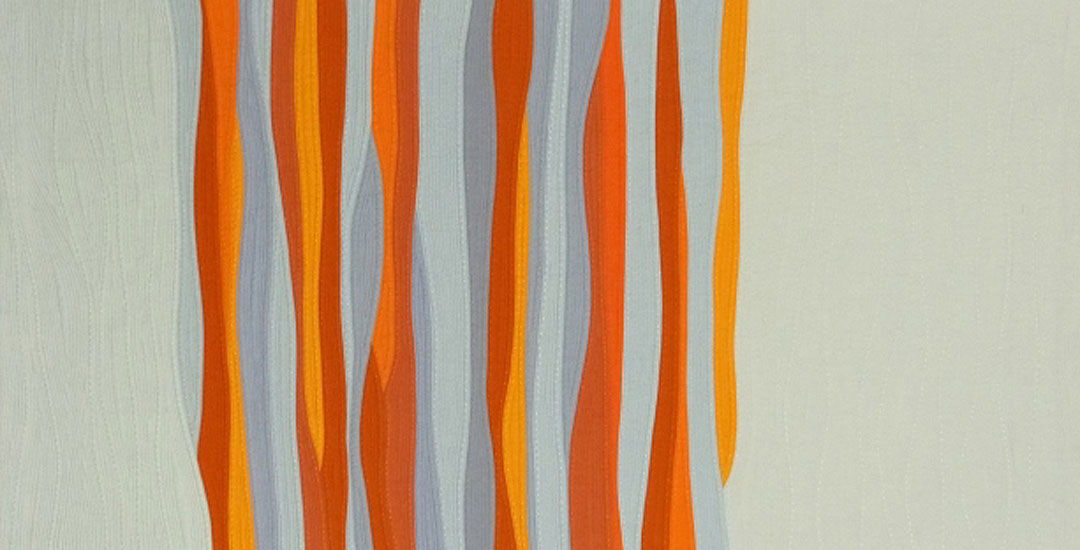As the world of quilting opens up to include many forms of textile art, several of us are beginning to explore ways to incorporate new and different materials in our work. I began with creating highly embellished art quilts, and have moved now into an art practice which incorporates a wide variety of materials and techniques that would rarely be found or taught in your local quilt shop (unless it‟s a “Hilary Rice” workshop)!We have encountered those adventurous souls that take a huge leap when they hear each progressively weirder way to do different stuff, and without safety entering their minds, off they trot to their quilt guild to do a demo. It is time that we thought about things a little before blindly exposing our friends to hazardous fumes and chemicals. Because that‟s what you get when you melt a synthetic fabric – toxic fumes!
For those of you that have attended my workshops, you‟ve heard the nervous giggles that run through the room when I get out my blowtorch! Jokes are made about burning the building down. I have also dyed my own fabrics for years, for my “Mother Earth Designs” kits and for personal use. Then there are the looks that I get during my guild‟s Show & Share sessions when I speak of melting synthetic fabrics with my heat gun. There are so many wonderful textures that result from applying heat, it is very worthwhile experimenting. So, I do strange things sometimes, but I have learned to be careful, being as safe as possible. Here are some of the ways that I ensure my personal safety, keeping me working happily for years to come:
- Work in a separate room in the house, far from the kitchen and most of the living quarters, with a door that closes. Oh, and remember – no pets in this space, because they can be affected too!
- If you work with flame (candle; blowtorch) or apply heat (embossing or heat gun; soldering iron) figure out a way to add a metal top to your work surface… I used to work on an old cookie sheet before my husband made me a wonderful new table covered with galvanized steel obtained from the local metal shop. Work with a spray water bottle at your side – remember flames will travel underneath the fabric, out of sight. Install a fire extinguisher, too.
- When working with powders (dye powder; pigment powder; bronzing powder; embossing powder) and when melting and burning fabrics, don‟t just hold your breath! You don‟t want the inside of your nose to look like you were playing with magic markers up there! Plus, the fumes from those melted synthetic fabrics are dangerously risky to breathe. Wear a respirator mask – the kind that goes over your nose and mouth, fitted with an organic vapour filter. Yeah, yeah… it makes you look like Darth Vader. Just be sure to stop working a few hours before you have a fancy dinner to attend – the mask leaves pressure lines around your muzzle! And if you have friends over for a “play day‟, take it outside, or insist they have a mask to wear too – about a $35 investment, but for saving your health – priceless (as they say).
- I wear a lab coat with long sleeves, and rubber gloves. These items stay in my “messy studio” so they don‟t contaminate the rest of the house. Dye particles will cling to your clothing.
- Install a seriously strong fan that sucks the air to the outdoors – mine is connected into the clothes dryer vent. I leave it running for about an hour or so after I‟ve conducted a “melt and burn” session. Also, it is amazing how dye particles travel – try placing a damp white cloth in a corner of the room you‟re dyeing in… it will get spots of colour after just a few minutes! Limited space? Use a dye box – a small Plexiglass box with holes for your hands. Or work outdoors.
If you are thinking of trying out any new form of art – learn about your materials before starting to make purchases. There are some less toxic choices available. You can also write to the product manufacturer to obtain a Material Safety Data Sheet (MSDS) (to be provided, by law, upon request), just to be really safe!
I could tell you all the nasty things about chemicals, small airborne particles and fumes and what they do to us. But mostly, your safety is common sense stuff. If you’re working with a powder, wear a filtering mask. If it’s smelly and you aren’t sure, wear a respirator mask and open a window with a fan positioned to blow the air out or even move things outside for the brief time that you will be working. This is what is meant when it’s suggested to work in a well ventilated area. Remember that old saying: “It‟s better to be safe than sorry.”
Happy creating!
www.mestudios.ca

